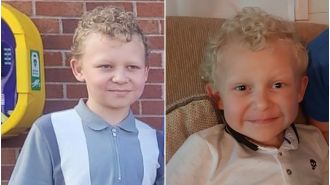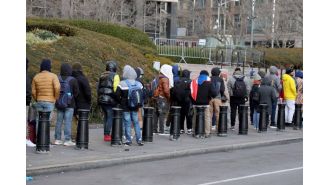Influential Texas Commission Says Blood-Spatter Testimony in Joe BryanŌĆÖs Murder Case Was ŌĆ£Not Accurate or Scientifically SupportedŌĆØ
The findings of Texas Forensic Science Commission will make it harder to deny a new trial to Bryan, a high school principal convicted of murdering his wife. The case was the subject of an investigation by ProPublica and The New York Times Magazine.
An influential state commission said the blood-spatter analysis used to convict a former Texas high school principal of murdering his wife in 1985 was ŌĆ£not accurate or scientifically supportedŌĆØ and the expert who testified was ŌĆ£entirely wrong.ŌĆØ
The findings of the Texas Forensic Science Commission, a national leader in forensic science reform, called into question the conviction of Joe Bryan, who has now spent more than 30 years in prison.
Bryan was the subject of a two-part investigation by ProPublica and The New York Times Magazine in May that questioned the accuracy of the bloodstain pattern analysis used to convict Bryan, as well as the training of the experts who testify in such cases.
The findings, which were released during a commission meeting Friday, give fresh urgency to the pleas of Bryan, now 77 and in poor health, for a new trial. Bryan had been attending a principalsŌĆÖ convention in Austin, 120 miles from where the murder occurred, in the days surrounding the murder. He has always maintained that he was in Austin, asleep in his hotel room, at the time of the crime.
Created by the Texas Legislature in 2005, the commission ŌĆö made up of seven scientists, one prosecutor and one defense attorney ŌĆö does not investigate the guilt or innocence of defendants, but rather the reliability and integrity of the forensic science used to win their convictions. Earlier this year, its inquiry into the Bryan case broadened into a re-examination of bloodstain-pattern analysis, a forensic discipline whose practitioners regard the drops, spatters and trails of blood at a crime scene as clues that can sometimes be used to reverse-engineer the crime itself.
The commission examined the training of some of the disciplineŌĆÖs practitioners, who have been admitted as expert witnesses in courts around the country despite having completed no more than a weeklong course in bloodstain interpretation.
Robert Thorman, a police detective from Harker Heights, Texas, with 40 hours of training in bloodstain-pattern analysis, was a key prosecution witness in the Bryan case. His testimony about a blood-speckled flashlight found by the victimŌĆÖs brother in the trunk of BryanŌĆÖs car four days after the murder was the linchpin of the prosecutionŌĆÖs case.
Yet what connection the flashlight had to the crime, if any, was never clear. In 1985, a crime lab technician working before the advent of DNA analysis determined the blood on the flashlight to be type O, which corresponded not only to BryanŌĆÖs wife, Mickey, but also to nearly half the population.
To secure a guilty verdict, prosecutors needed to tie the flashlight to the crime scene. Based on his assessment of photographs of the flashlight, Thorman testified that the flecks of blood on its lens were ŌĆ£back spatterŌĆØ ŌĆö a pattern that indicated a close-range shooting. With the help of prosecutors, he wove a narrative that suggested the flashlight had been present at the crime scene ŌĆö specifically, that the killer was holding the flashlight in one hand at the time that he shot Mickey Bryan.
At FridayŌĆÖs meeting in Austin, bloodstain-pattern analyst Celestina Rossi provided a highly critical assessment of ThormanŌĆÖs interpretation of both the crime scene and the flashlight. ŌĆ£ThormanŌĆÖs testimony was egregiously wrong,ŌĆØ Rossi said after the meeting. ŌĆ£If any juror relied on any part of his testimony to render a verdict, Mr. Bryan deserves a new trial.ŌĆØ
After the publication of the story by ProPublica and The New York Times Magazine, the Texas Forensic Science Commission asked Rossi, a locally prominent bloodstain-pattern analyst, to re-examine the case. The commission had previously retained another analyst, whose findings about the complex case were brief and did not fully answer the commissionŌĆÖs questions.
RossiŌĆÖs assessment, which was based on more than 60 hours of research and analysis, supported and expanded upon many of the articleŌĆÖs findings about ThormanŌĆÖs work.
Rossi found that the detective misstated scientific concepts, used flawed methodology and incorrectly interpreted evidence. Both his analysis and his expert testimony were not scientifically accurate, she told the commission, and could not be supported by published research or data.
Among the erroneous claims that Thorman made on the stand, Rossi found, was his contention that blood evaporated after traveling 46 inches through the air. He also testified ŌĆö incorrectly ŌĆö that ŌĆ£human blood has its own characteristic geometric patterns.ŌĆØ Neither of these assertions pertained directly to the evidence in the case, but they showed ThormanŌĆÖs fundamental lack of understanding of basic scientific principles, she said.
Most significantly, Rossi dismantled the prosecutionŌĆÖs single-most important contention: that the blood-spattered flashlight was present at the crime and held by the killer. Rossi determined that the dark-brown flecks on the flashlight did not ŌĆ£radiate back in a radiating patternŌĆØ as they would in ŌĆ£a back-spatter event.ŌĆØ In other words, the bloodstains were not consistent with a close-range shooting.
Thorman, who is now retired, declined to comment on RossiŌĆÖs findings, explaining that he would wait to do so until the commission releases its final report in October. But, he said, ŌĆ£I did what I was trained to do.ŌĆØ
RossiŌĆÖs findings carried particular weight because she is a law enforcement officer, not a paid expert retained by the defense. A veteran crime scene investigator with the Montgomery County SheriffŌĆÖs Office crime laboratory in Conroe, Texas, north of Houston, Rossi frequently testifies as a prosecution witness in trials around the state. She was recently appointed to a working group overseen by the National Institute of Standards and Technology that is charged with strengthening standards across the discipline.
RossiŌĆÖs analysis of the Bryan case was not the only setback to the prosecution. Lynn Garcia, the commissionŌĆÖs general counsel, said that Patricia Almanza, a state crime lab technician who testified extensively about blood and trace evidence in the case, had repeatedly made assertions that went beyond her fields of expertise. In response to questioning by a prosecutor, Almanza had given her opinion about the characteristics of blood spatter, though she was not qualified to do so, and gave an opinion about fiber evidence that she had not tested.
Almanza, who now goes by the name Retzlaff, could not be reached for comment.
But perhaps the biggest blow to Adam Sibley, the Bosque County district attorney, who has so far successfully blocked BryanŌĆÖs efforts to have DNA analysis performed on previously untested evidence, was GarciaŌĆÖs suggestion that the commission may recommend that DNA testing proceed when it issues its final report. (Doing so would require the district attorneyŌĆÖs office to abandon its appeal of a 2017 court ruling, which had ordered testing to begin.) This testing would include further analysis of the flashlight. In 2012, a test for the presence of blood on the lens was performed but came back negative.
Sibley listened attentively throughout the presentation on Friday, which took place in a conference room at the Texas Supreme Court that was crowded with forensic scientists, attorneys and Texas Rangers. A justice from the Texas Court of Criminal Appeals, the court that will ultimately decide whether Bryan is granted a new trial, also watched the presentation.
Sibley declined to comment on the Bryan case, citing ongoing litigation. But the commissionŌĆÖs preliminary findings, announced in a public hearing attended by some of the stateŌĆÖs foremost jurists and forensic scientists, may make it harder for him to justify his ongoing efforts to prevent further DNA testing.
The next chapter in the Bryan case will begin on Aug. 20, when a three-day evidentiary hearing will take place in the district court in Comanche, Texas. BryanŌĆÖs attorneys, Walter Reaves and Jessica Freud of Waco, will present witnesses and evidence to support their argument that Bryan should be granted a new trial. The presiding judge will then make recommendations to the Texas Court of Criminal Appeals, whose justices will be the final arbiters.
Regardless, the Bryan case has already spurred forensic science reform. In February, the commission sought to end the practice of allowing law enforcement officers with minimal training in bloodstain-pattern analysis to testify in Texas, stipulating that such analysis must be performed by an accredited organization if it is to be allowed in court.
The decision is expected to prompt other states to follow suit, as the commissionŌĆÖs reforms often do.
As for the Bryan case, the consensus among observers on Friday was that the prosecutionŌĆÖs job of defending the decades-old conviction had become far more difficult. The Bosque County district attorneyŌĆÖs officeŌĆÖs insistence on doing so, particularly in light of the commissionŌĆÖs findings, ŌĆ£continues to defy logic and pervert justice,ŌĆØ Freud said. ŌĆ£If the state had to try this case tomorrow, it would be nearly impossible to secure a conviction.ŌĆØ






